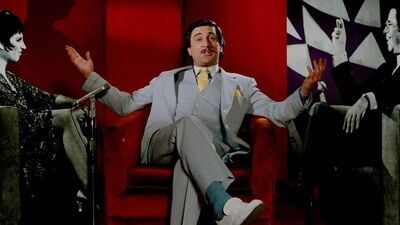Mainly for getting rid of Pupkin, Langford makes a little inconsequential promise in the end. Alas, this leads to more delusion in Pupkin’s troubled mind, and then the movie begins to blur the line between reality and delusion. As his delusion is getting bloated more and more, Pupkin’s pathetic reality is much more obvious to us, and we get a small bitter laugh whenever Pupkin’s self-absorbed state is disrupted by the voice of his annoyed mother from upstairs. (It is actually the voice of Scorsese’s mother, by the way).
At least, Pupkin gets a likely chance for admiration via Rita Keene (Diahnne Abbott), a young Black female bartender who was one of Pupkin’s schoolmates during his high school years. Probably because of their old time’s sake, she lets him have a dinner date with her, and he gladly boosts himself a lot in front of her, but she is just mildly amused while noticing more of what is going on right behind his back. Scorsese makes an interesting visual choice here; as the camera keeps focusing on Pupkin and Keene, a sense of embarrassment slowly dawns upon us, and we cringe more and more.
Meanwhile, Pupkin is getting rejected again and again by Langford and his associates. This eventually results in one of the most painfully embarrassing moments in the film, but, curiously, Scorsese presents this supposedly big comic moment as dryly as possible. The camera of his cinematographer Fred Schuler often sticks to static positions, and it usually maintains the distance from the main characters while mostly avoiding close-ups throughout the movie. In addition, the spaces occupied by the main characters frequently feel empty and barren without much sense of life. Langford’s apartment and country house look more like under-furnished art galleries than real human places to live, and New York City in the film is presented as a bland and uncaring urban environment where its main characters are isolated in one way or another.

